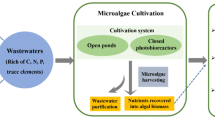Abstract
Two culture modes, continuous and semi-continuous, of the decolorization fungus,Geotrichum candidum Dec 1, were compared to obtain a high treatment efficiency of molasses decolorization and a large productivity of peroxidase (DyP) to simultaneously decolorize dyes and molasses. The continuous culture ofG. candidum Dec 1 using a 5-l jar-fermentor showed high DyP activity at a low dilution ratio of 0.005h−1, and decolorization ratio of molasses of 80% was obtained concomitantly. Therefore, a semi-continuous culture was performed by repeated refill and draw. In this mode, approximately 1.5 liters of the culture broth was replaced per cycle when the decolorization ratio of molasses was near 80%. The molasses medium (1.0 liter per day) was treated and the peroxidase productivity in the drawn culture broth was 26.6 U/day, whereas the peroxidase productivity was 17.9 U/day in the continuous culture with a dilution rate of 0.005 h−1. The semi-continuous treatment system was an efficient decolorization method for the strain,G. candidum Dec 1.
Similar content being viewed by others
References
Kim, S. J., K. Ishikawa, M. Hirai, and M. Shoda (1995) Characteristics of a newly isolated fungus,Geotrichum candidum Dec I, which decolorizes various dyes.J. Ferment. Bioeng. 79: 601–607.
Kim, S. J., and M. Shoda (1999) Burification and characterization of a novel peroxidase fromGeotrichum candidum Dec 1 involved in decolorization of dyes.Appl. Environ. Microbiol. 65: 1029–1035.
Kim, S. J., N. Suzuki, Y. Uematsu, and M. Shoda (2001) Characterization of aryl alcohol oxidase produced by dyedecolorizing fungus,Geotrichum candidum Dec 1.J. Biosci. Bioeng. 91: 166–172.
Kim, S. J., and M. Shoda (1999) Decolorization of molasses and a dye by a newly isolated strain of the fungusGeotrichum candidum Dec 1.Biotechnol. Bioeng. 62: 114–119.
Kim, S. J., and M. Shoda (1998) Decolorization of molasses by a new isolate ofGeotrichum candidum in a jar fermenter.Biotechnol. Tech. 12: 497–499.
Perie, F. H., and M. H. Gold (1991) Manganese regulation of manganese peroxidase expression and lignin degradation by the white rot fungusDichomitus squalens.Appl. Environ. Microbiol. 57: 2240–2245.
Sayadi, S., and R. Ellouz (1995) Roles of lignin peroxidase and manganese peroxidase fromPhanerochaete chrysosporium in the decolorization of olive mill wastewaters.Appl. Environ. Microbiol. 61: 1098–1103.
Goszczynski, S., A. Paszczynski, M. B. Pasti-Grigsby, R. L. Crawford, and D. L. Crawford (1994) New pathway for degradation of sulfonated azo dyes by microbial peroxidases ofPhanerochaete chrysosporium andStreptomyces chromofuscus.J. Bacteriol. 176: 1339–1347.
Chivukula, M., and V. Renganathan (1995) Phenolic azo dye oxidation by laccase fromPyricularia oryzae.Appl. Environ. Microbiol. 61: 4374–4377.
Woo, S. H., J. S. Cho, B. S. Lee, and E. K. Kim (2004) Decolorization of melanin by lignin peroxidase fromPhanerochaete chrysosporium.Biotechnol. Bioprocess Eng. 9: 256–260.
Venkatadri, R., and R. L. Irvine (1990) Effect of agitation on ligninase activity and ligninase production byPhanerochaete chrysosporium.Appl. Environ. Microbiol. 56: 2684–2691.
Kirkpatrick, N., and J. M. Palmer (1987) Semi-continuous ligninase production using foam-immobilisedPhanerochaete chrysosporium.Appl. Microbiol. Biotechnol. 27: 129–133.
Linko, S. (1988) Continuous production of lignin peroxidase by immobilizedPhanerochaete chrysosporium in a pilot scale bioreactor.J. Biotechnol. 8: 163–170.
Pallerla, S., and R. P. Chambers (1995) Continuous decolorization and AOX reduction of bleach plant effluents by free and immobilizedTrametes versicolor.J. Environ. Sci. Health. A30: 423–437.
Bonnarme, P., M. Delattre, H. Drouet, G. Corrieu, and M. Asther (1993) Toward a control of lignin and nanganese peroxidases hypersecretion byPhanerochaete chrysosporium in agitated vessels: Evidence of the superiority of pneumatic bioreactors on mechanically agitated bioreactors.Biotechnol. Bioeng. 41: 440–450.
Leisola, M. S. A., U. Thanei-Wyss, and A. Fiechter (1985) Strategies for production of high ligninase activities byPhanerochaete chrysosporium.J. Biotechnol. 3: 97–100.
Bonnarme, P., M. Delattre, G. Corrieu, and M. Asther (1991) Peroxidase secretion by pellets or immobilized cells ofPhanerochaete chrysosporium BKM-F-1767 and INA-12 in relation to organelle content.Enzyme Microb. Technol. 13: 727–733.
Leisola, M. S. A., and A. Fiechter (1985) New trend in lignin biodegradation.Adv. Biotechnol. Proc. 5: 59–89.
Pinelli, D., R. A. Gonzalez-Varay, D. Matteuzzi, and E. Magelli (1997) Assessment of kinetic models for the production of L- and D-lactic acid isomers byLactobacillus casei DMS 20011 andLactobacillus coryniformis DMS 2004 in continuous fermentation.J. Ferment. Bioeng. 83: 209–212.
Kirkpatrick, N., and J. M. Palmer (1989) A natural inhibitor of lignin peroxidase activity fromPhanerochaete chrysosporium, active at low pH and inactivated by divalent metal ions.Appl. Microbiol. Biotechnol. 30: 305–311.
Wittier, R., H. Baumgartl, D. W. Lübbers, and K. Schügerl (1986) Investigation of oxygen transfer intoPenicillium chrysogenum pellets by microprobe measurements.Biotechnol. Bioeng. 28: 1024–1036.
Linko, Y.-Y., M. Leisola, N. Lindholm, J. Trolle, P. Linko, and A. Fiechter (1986) Continuous production of lignin peroxidase byPhanerochaete chrysosporium.J. Biotechnol. 4: 283–291.
Linko, S. (1988) Production and characterization of extracellular lignin peroxidase from immobilizedPhanerochaete chrysosporium in a 10-1 bioreactor.Enzyme Microb. Technol. 10: 410–417.
Capdevila, C., G. Corrieu, and M. Asther (1989) A feed-harvest culturing method to improve lignin peroxidase byPhanerochaete chrysosporium INA-12 immobilized on polyurethane foam.J. Ferment. Bioeng. 68: 60–63.
Ryu, B. H. (2004) Semicontinuous decolorization of azo dyes by rotating dise contactor immobilized withAspergillus sojae B-10.Biotechnol. Bioprocess Eng. 9: 309–312.
Author information
Authors and Affiliations
Corresponding author
Rights and permissions
About this article
Cite this article
Kim, S.J., Kim, M.J. & Shoda, M. Decolorization of dye and molasses by continuous and semi-continuous jar-fermentor cultures ofGeotrichum candidum Dec 1. Biotechnol. Bioprocess Eng. 11, 306–312 (2006). https://doi.org/10.1007/BF03026245
Received:
Accepted:
Issue Date:
DOI: https://doi.org/10.1007/BF03026245




